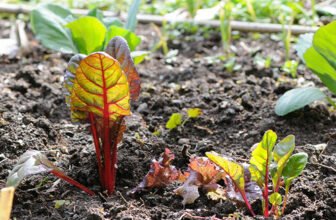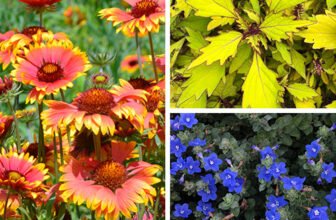
[ad_1]
A backyard is no place for a farm. My earliest vegetable gardens were small-scale imitations of large-scale farms. I rototilled the soil, spread bagged chemical fertilizer all around and built neat hills and straight furrows. I worked as a tractor. Then I unleashed a flood of water to fill the furrows and bring life to the land. I engineered like a god. Months later, I would make my daily rounds to harvest what I could from the hard, gray soil that was cracking under the intense summer sun. Farming was a tough life.
Did it have to be so tough? In reading about vegetable growing, I discovered that it did not.
The key to successful gardening is taking good care of the soil. By deeply cultivating the soil and adding plenty of organic matter and natural fertilizers, I not only increased the production of my garden many times over but also entered into a new relationship with my soil. I tended it and nurtured it, and my backyard farm gradually became a garden.

Dig the soil, but don’t turn it over
If you’re making a new bed on the unbroken ground, use a spading shovel to cut the edges. Then loosen the ground with a digging fork, thrusting it as deep into the soil as you can. Rock the handle back to loosen and lift the soil, but try not to turn it over. Remember that soil is a vibrant ecosystem that suffers if it’s exposed to too much light and air. So just wiggle the fork around to make it easier for roots to penetrate. Deep cultivation will encourage the roots to grow downward. If you can dig your bed only 6 to 8 inches deep the first year, don’t worry. Earthworms and plant roots will penetrate even farther, loosening the soil so that you can dig a little deeper the following year.
I don’t use a rototiller to loosen the soil. Excessive mechanical tilling can destroy organic matter by overaerating the soil. It can also create a layer of compacted soil in the subsoil just below the depth where the blades reach. Roots will have a tough time growing down into such hard soil. Besides, tillers are noisy, smoky, and tricky to maneuver in small spaces.
Break up soil clumps, and rake out the grass. Use a cultivator or a rake to work over the bed, giving it a rough shape, breaking up clumps of soil, and pulling out grass as you go. For this task, I rely on a cultivator I’ve had for years; once I’ve completed the initial groundbreaking with a digging fork, I can do almost everything else with my cultivator.
You’ll need to loosen the soil and break up clumps each year in preparation for planting, but it doesn’t take as much effort as it will the first year.

 Feed the soil with organic matter
Feed the soil with organic matter
The bacteria, fungi, actinomycetes, and other organisms that inhabit your soil will convert the food that you give them (compost, manure, organic fertilizers, or plant residues) into nutrients for your growing plants. As they release nutrients, these organisms are also creating humus (minuscule particles of decomposed organic matter) and binding soil particles into irregular clumps. Over time, the regular addition of organic matter will improve the structure of your soil. It will help sandy soil hold water and nutrients longer, and will help clay soil drain faster and allow roots to penetrate it more easily.
The first time I prepare a bed, I add at least 3 inches of compost. That works out to about a cubic yard for every 100 square feet. You can use homemade compost, livestock manure, commercial compost, or mushroom compost—whatever may be cheap, abundant, and available. Because this initial amending is large, it pays to shop around for a material that you can get in bulk rather than in bags. I would avoid sawdust. The high carbon content of wood products tends to reduce the availability of nitrogen in the soil.

I rake the manure out evenly over the bed and cut it into the top 3 to 4 inches of soil, using either a cultivator or a fork. If you use a digging fork, stir in the compost with a twisting motion. If you find it awkward to reach to the center of the bed with a fork, lay a board across the bed to give you a place to stand without compacting the soil. Finally, I use my rake to blend the manure evenly and shape the bed surface.
In the following seasons, you will need to add only an inch or two of organic matter. Remember, however, that no two years are alike—in weather conditions or in the crops you choose to grow. So be adaptable, and pay close attention to your soil. If it begins to lose its crumbly structure or gets hard or sticky, you can add organic matter in spring and again in fall. A warm summer combined with moderate watering and intensive planting can use up the organic matter quickly.
Don’t forget the fertilizer
Organic matter is essential for the smooth functioning of soil life. But when you are growing vegetables, you cannot rely on organic matter alone to supply all of the necessary nutrients. Plants need plenty of nitrogen, phosphorus, and potassium (the N-P-K on a fertilizer bag) and lesser amounts of nutrients such as copper, magnesium, boron, and iron (the so-called trace minerals or micronutrients).
Manure from cows, horses, or other herbivores and compost of decomposed plant material will contain most of the trace minerals your soil needs. Most soils already have adequate phosphorus and potassium. Nitrogen’s most important role is to promote vegetative tissue (leaves and stems), so it’s essential for healthy plant growth. And it is soluble, which means that it can be washed out of the root zone, away from your plants. So nitrogen needs to be renewed regularly.
I use organic sources of nitrogen to feed the soil, not chemical fertilizers to feed the plant. Organic materials have to be digested by soil microorganisms in order to release nutrients. This slower process is dependent on soil temperature, moisture, and the size, density, and composition of the organic material. The biological activity you encourage by using natural materials will improve your soil, which, in turn, will lead to healthier plants.
I use fish meal (dried and pulverized fish waste) to supply my growing plants with nitrogen. It’s available from mail-order, farm-supply, and garden-supply companies. If you want a more available organic source of nitrogen, you can use dried blood meal. It’s less expensive than a fish meal but doesn’t supply quite as wide a range of nutrients.
Here in the West, nitrogen is generally in short supply, so my standard dosage is ½ pound per 100 square feet. Your soil might not need quite as much nitrogen as mine does. To know for sure, you’d have to have it tested by a soil lab. But most gardeners can probably safely apply ½ pound of nitrogen per 100 square feet so long as it’s a slow-release organic fertilizer.
I broadcast the fish meal over the bed and chop it in with a rake. I’m careful not to rake it in because I want it to stay evenly distributed. Because our summers are dry and water is precious, I then use the back of the rake to smooth the surface flat so that the bed will catch all the water I put on it.
Now the soil is loosened and amended. The beds are shaped and fertilized. The microorganisms are ready to go to work for you as soon as you add water and plants. Just remember that you are creating more than just a garden. You are managing a simplified ecosystem. Learn to work with nature. Strive to create the conditions that allow for healthy growth. You’ll get more from your garden than you ever expected.
Steps for boosting your soil every year
- Loosen the soil as deeply as you can, but don’t turn it over.
- Break up clumps of soil.
- Add plenty of organic matter.
- Chop in a nitrogen-rich fertilizer.
- Stay on the paths and out of the beds to avoid compacting the soil.
[ad_2]






